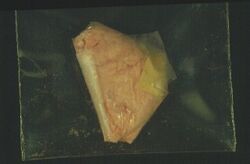Assessment |
Biopsychology |
Comparative |
Cognitive |
Developmental |
Language |
Individual differences |
Personality |
Philosophy |
Social |
Methods |
Statistics |
Clinical |
Educational |
Industrial |
Professional items |
World psychology |
Biological: Behavioural genetics · Evolutionary psychology · Neuroanatomy · Neurochemistry · Neuroendocrinology · Neuroscience · Psychoneuroimmunology · Physiological Psychology · Psychopharmacology (Index, Outline)
| Mescaline | |
|---|---|
| Chemical name | 3,4,5-Trimethoxy- phenethylamine or 2-(3,4,5-trimethoxyphenyl) ethanamine |
| Chemical formula | C11H17NO3 |
| Molecular mass | 211.26 g/mol |
| Melting point | 128–129 °C |
| CAS numbers | 54-04-6 |
| SMILES | NCCC1=CC(OC)=C(OC)C(OC)=C1 |
| Chemical structure of mescaline | |
Mescaline (3,4,5-trimethoxyphenethylamine) is a hallucinogenic alkaloid of the phenethylamine class.
It occurs naturally in the peyote cactus (Lophophora williamsii), the San Pedro cactus (Echinopsis pachanoi) and the Peruvian Torch cactus (Echinopsis peruviana), and it is also found in a number of other members of the Cactaceae. It can be extracted from these sources. Mescaline was first isolated and identified in 1897 by the German Arthur Heffterand first synthesized in 1919 by Ernst Späth.
Usage and history[]

Mescaline powder
The use of extract from peyote in Native American religious ceremonies has been noted since the earliest European contact, notably by the Huichols in Mexico.
Dosage and effects[]
For the drug to take effect, disk-shaped buttons are cut from the roots, on the top of the cactus, and dried. It is chewed to produce its effect or soaked in water for an intoxicating drink. The effective human dosage is 0.3–0.5 grams, with the effects lasting for up to 12 hours. Users typically experience visual hallucinations and radically altered states of consciousness, often experienced as pleasurable and illuminating but occasionally as accompanied by feelings of anxiety or revulsion. It is not physically addictive.
Legal status[]
In the US it was made illegal in 1970 by the Comprehensive Drug Abuse Prevention and Control Act. It was prohibited internationally by the 1971 Convention on Psychotropic Substances[1] and is categorized as a Schedule I hallucinogen by the CSA.
Chemistry[]
A common synthetical approach starts from 3,4,5-trimethoxybenzaldehyde. the chemecial make-up is C11H17NO3(PiHKAL entry).
Effects and side effects[]
One or more of the following effects may or may not accompany any individual experience with mescaline.
- Open eye visuals
- Closed-eye visuals
- New thought processes
- Dream-like scenarios
- Euphoria
- Mystical experience
- Pupil dilation
- Sensations of warm and cold
- Temporary splitting/destruction of ego
- Dizziness
- Vomiting
- Tachycardia
- Diarrhea
- Headaches
- Anxiety
- Feeling of dying
- Fear of not being able to return to normal consciousness
- Hallucinogen persisting perception disorder (HPPD)
- Irrationality of the thought-process
See also[]
- The Doors of Perception
- The Teachings of Don Juan
- List of notable people who have taken psychedelic drugs
- MKULTRA
- Phenethylamines
- Psilocybin
- Psychedelics in popular culture
- Peyote
- Native American Church
- PiHKAL
- Psychedelic drug
- Psychoactive drug
- [[2]]
- Humphry Osmond
References & Bibliography[]
Key texts[]
Books[]
Papers[]
Additional material[]
Books[]
Papers[]
External links[]
- Mescaline at Erowid
- PiHKAL entry
- Mescaline: The Chemistry and Pharmacology of its Analogs Essay by Alexander Shulgin
- Link page to external chemical sources.
Categorization[]
Psychedelic phenethylamines
| |
|---|---|
Aleph • 2C-B • 2C-B-FLY • 2C-C • 2C-D • 2C-E • 2C-F • 2C-G • 2C-I • 2C-N • 2C-O • 2C-O-4 • 2C-P • 2C-T • 2C-T-2 • 2C-T-4 • 2C-T-7 • 2C-T-8 • 2C-T-9 • 2C-T-13 • 2C-T-15 • 2C-T-17 • 2C-T-21 • 2C-TFM • 3C-E • 3C-P • Br-DFLY • DESOXY • DMMDA-2 • DOB • DOC • DOET • DOI • DOM • DON • Escaline • Ganesha • HOT-2 • HOT-7 • HOT-17 • Isoproscaline • Lophophine • MDA • MMDA • MMDA-2 • MMDA-3a • MMDMA • Macromerine • Mescaline • Proscaline • TMA |
| This page uses Creative Commons Licensed content from Wikipedia (view authors). |